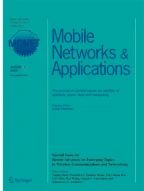Abstract
Internet of Things (IoT) makes possible diverse smart applications through incorporating information from various sensors and enabling interoperability among different control systems. Adopting IoT in smart building paradigm enables efficient design, control, and management of converged infrastructures. As one of the dominated wireless communication standards adopted in smart buildings-oriented IoT architecture, IEEE 802.11-series standards are expected to play an important role in the nascent IoT. Furthermore, heterogeneous sensors, devices, and controllers deployed for different smart ‘silos’ could connect and collaborate with each other via the converged wireless networks. To simultaneously support a large number of devices, it is critical to know the transmission capacity of the network in the design stage, especially when malicious jamming attacks exist. In this backdrop, stochastic geometry theory is adopted in this paper to investigate the throughput of IEEE 802.11 enabled IoT, where a ring model is put forward to capture the distribution of legitimate nodes and jammers. Afterwards, the collision probability of wireless transmission is derived from the perspective of both physical layer and MAC layer. Then, the throughput of each IoT node is calculated. To validate our models, numerical tests as well as simulation results derived on NS3 are provided with various parameter settings. Simulation results show that our models could accurately characterize the performance of IEEE 802.11-enabled wireless networks under jamming attacks.
Similar content being viewed by others
References
Raptis T, Passarella A, Conti M (2018) Performance analysis of latency-aware data management in industrial iot networks. Sensors 18(8):2611
King RO (2016) Cyber security for intelligent buildings. IET Engineering & Technology Reference, pp 1–6
Wang T, Wei X, Hu F, Fan J (2018) Mobile jammer localization and tracking in multi-hop wireless network. Journal of Ambient Intelligence and Humanized Computing, pp 1–12
Bianchi G (2000) Performance analysis of the IEEE 802.11 distributed coordination function. IEEE J Sel Area Comm 18:535–547
Chen Y, Chen F, Wu T, Hu W, Xu X (2018) A deep learning model for secure cyber-physical transportation systems. In: IEEE INFOCOM 2018-IEEE Conference on Computer Communications Workshops (INFOCOM WKSHPS). IEEE, pp 1–2
Rajanna A, Bergel I, Kaveh M (2015) Performance analysis of rateless codes in an ALOHA wireless ad hoc network. IEEE Trans Wirel Commun 14(11):6216–6229
Feukeu EA, Djouani K, Kurien A (2014) Performance and comparative analysis of ADSA in a vehicular network: Mac approach in IEEE 802.11p. Procedia Comput Sci 32:537–544
Wei X, Wang Q, Wang T, Fan J (2017) Jammer localization in multi-hop wireless network: a comprehensive survey. IEEE Commun Surv Tutor 19(2):765–799
Zou Y, Zhu J, Wang X, Hanzo L (2015) A survey on wireless security: Technical challenges, recent advances, and future trends
Wang T, Wei X, Fan J, Liang T (2018) Adaptive jammer localization in wireless networks. Comput Netw 141:17–30
Pelechrinis K, Iliofotou M, Krishnamurthy SV (2011) Denial of service attacks in wireless networks: the case of jammers. IEEE Commun Surv Tutor 13(2):245–257
Wei X, Wang T, Tang C, Fan J (2018) Collaborative mobile jammer tracking in multi-hop wireless network. Futur Gener Comput Syst 78:1027–1039
Amuru SD, Buehrer RM (2015) Optimal jamming against digital modulation. IEEE Trans Inf Forensics Secur 10(10):2212–2224
Bayraktaroglu E, King C, Liu X, Noubir G, Rajaraman R, Thapa B (2013) Performance of IEEE 802.11 under jamming. Mobile Netw Appl 18(5):678–696
Ye S, Panwar S (2009) Analysis of carrier sensing’s influence on the performance of routing protocols in multi-hop, multi-rate wireless networks. In: Wireless Communications and NETWORKING Conference, 2009, WCNC, pp 1–6
Gezici S, Gholami MR, Bayram S, Jansson M (2015) Jamming of wireless localization systems. IEEE Trans Commun 64(6):2660–2676
Gezici S (2015) Optimal jamming of wireless localization systems. In: IEEE International Conference on Communication Workshop, pp 2660–2676
Feng J, Pasiliao EL, Dixon WE, Shea JM (2015) An optimal jamming strategy to partition a wireless network. In: Military Communications Conference, Milcom 2015
Li M, Koutsopoulos I, Poovendran R (2010) Optimal jamming attack strategies and network defense policies in wireless sensor networks. IEEE Trans Mob Comput 9(8):1119–1133
Renzo MD, Lu W (2015) The equivalent-in-distribution (EiD)-Based approach: On the analysis of cellular networks using stochastic geometry. IEEE Commun Lett 18(5):761–764
Amuru S, Tekin C, Van der Schaar M, Buehrer RM (2015) A systematic learning method for optimal jamming. In: IEEE International Conference on Communications, pp 2822–2827
Win MZ, Pinto PC, Shepp LA (2009) A mathematical theory of network interference and its applications. Proc IEEE 97(2):205–230
Punal O, Pereira C, Aguiar A, Gross J (2015) Experimental characterization and modeling of RF jamming attacks on VANETs. IEEE Trans Veh Technol 64(2):524–540
Sagduyu YE, Berryt RA, Ephremidesi A (2010) Wireless jamming attacks under dynamic traffic uncertainty. In: Proceedings of the International Symposium on Modeling and Optimization in Mobile, Ad Hoc and Wireless Networks, pp 303– 312
Cardieri P (2010) Modeling interference in wireless ad hoc networks. IEEE Commun Surv Tutor 12(4):551–572
Elkotby H, Mai V (2017) Interference modeling for cellular networks under beamforming transmission. IEEE Trans Wirel Commun PP(99):1–1
Ns3. Portal. [Online]. Available: http://www.nsnam.org
Acknowledgements
This research was supported in part by Jiangsu Province Natural Science Foundation of China under Grant No. BK20140068 and BK20150201.
Author information
Authors and Affiliations
Corresponding author
Additional information
Publisher’s Note
Springer Nature remains neutral with regard to jurisdictional claims in published maps and institutional affiliations.
Rights and permissions
About this article
Cite this article
Wei, X., Wang, T. & Tang, C. Throughput Analysis of Smart Buildings-oriented Wireless Networks under Jamming Attacks. Mobile Netw Appl 26, 1440–1448 (2021). https://doi.org/10.1007/s11036-019-01481-7
Published:
Issue Date:
DOI: https://doi.org/10.1007/s11036-019-01481-7
